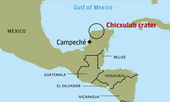So what really caused the dinosaurs to die out?
© GuardianSite of the meteorite strike.
Part of the mystery and allure of dinosaurs is their (relatively) sudden disappearance from the face of the Earth at the end of the Late Cretaceous epoch, 65m years ago. Many theories have been expounded to explain their sudden departure, with more fanciful ones including a build-up of methane from herbivorous dinosaur farts, mass blindness from cataracts, or an eradication of plantlife due to a global infestation of caterpillars.
It is, however, now widely accepted that the most likely cause of this mass extinction event (which, in fact, not only eradicated dinosaurs but 75% or more of all land-based animal species) is the impact of a huge meteorite that struck Earth around the coast of what is now the Yucatán peninsula in south-east Mexico.
Before there was direct evidence of such an impact, scientists had already been predicting a giant meteorite strike at this time due to the large amount of iridium found in the Earth's crust at a level corresponding to the end of the Cretaceous period (iridium is more common in meteorites than on Earth, and would have been scattered over the planet's surface as a fine dust after the meteorite strike). Then, in the late 1970s, the 110-mile diameter Chicxulub crater was identified by geophysicist Glen Penfield.
While it is impossible to measure the exact effect of the Chicxulub meteorite's impact, we know for sure there was a major change in the planet's ecosystems at this time.
The impact is thought to have thrown a lot of dust into the Earth's atmosphere, blocking out the sun and causing a sudden cooling event over much of the planet. This would have meant most plants could no longer photosynthesise and therefore died off, in turn causing herbivorous dinosaurs to die out, which would have led to the eradication of the carnivores, too.
Evidence for such a widespread dying out of plant life has been collected by palaeontologists studying pollen grains trapped in rocks from this time. Soon after this event, they found there was a superabundance of fern pollen, which is indicative of a lack of other plant life on the planet.
Scientists have speculated that other extreme events at this time may also have contributed to the disappearance of dinosaurs - for example, a series of extreme volcanic eruptions in India's Deccan plateau. But the relative suddenness of dinosaurs' eradication - less than a million years - implies a more immediate, global catastrophe. After all, prior to this time there is little evidence that the total number of dinosaur species had been decreasing significantly.
Despite such a catastrophic event, it is reckoned that between 75% and 90% of fresh-water animal species survived, as opposed to 12% to 28% of land-based species. This may be explained by the fact that fresh-water creatures generally don't feed on plantlife, so they would have, to some extent, been protected from the impact of a major plant die-off. After the extinction of dinosaurs, small mammals began to thrive, as did large predatory birds that are themselves now extinct.

Reader Comments
to our Newsletter